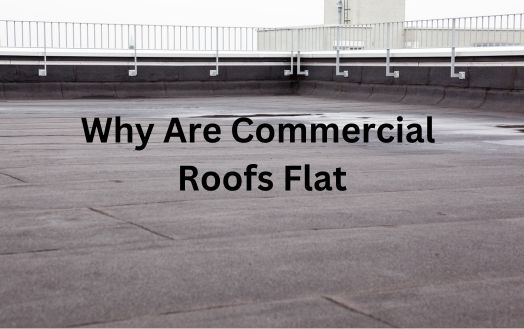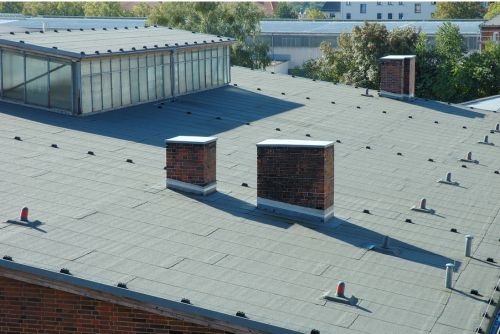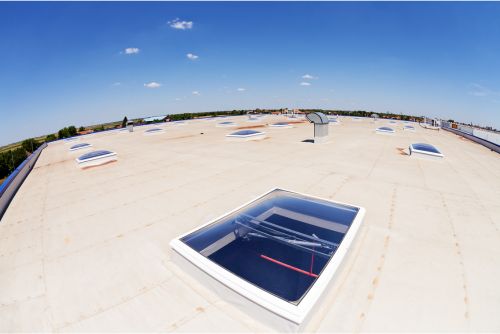
When you look at a commercial building, especially a large one, you might notice that the roof is flat. This might raise some questions in your mind, such as why are commercial roofs flat? Why aren’t they sloped like residential roofs? In this blog, we will explore the design, history, and advantages of flat roofs in commercial buildings. We will also delve into the different types of materials used for flat roofs and discuss their characteristics. By the end of this blog, you will understand why commercial roofs are flat and whether it might be the right choice for your commercial building.
To understand why are commercial roofs flat, we need to look at the design of these roofing systems. A flat roof is a common choice for commercial buildings, such as office complexes, industrial facilities, and shopping malls. Unlike sloped roofs commonly found in residential properties, flat roofs have a distinct structure and purpose. They are designed to be durable, cost-effective, and energy-efficient, while also providing ample space for various building systems and equipment.
The design of flat roofs in commercial buildings dates back centuries, with examples found in ancient architecture around the world. In commercial properties, flat roofs have been a popular choice, especially for large commercial buildings. The use of flat roofs in commercial real estate can be attributed to their practicality and suitability for such properties. They provide a vast surface area, allowing for more space utilization, whether for HVAC systems or additional interior spaces. Moreover, flat roofs have become synonymous with commercial districts, giving these areas a distinct architectural aesthetic.
The design of flat roofs in commercial buildings comes with several fundamental characteristics that make them appealing to property owners. First, flat roofs accommodate HVAC systems and other building equipment more easily, as compared to sloped roofs. Their spacious surface area allows for efficient installation and maintenance of these systems, contributing to the overall functionality of commercial buildings. Additionally, flat roofs provide cost and energy efficiency, as they require less material and labor during construction. They also eliminate the need for attic spaces, which saves on square footage and reduces energy loss. Lastly, flat roofs are durable, capable of withstanding UV rays and other external factors, ensuring years of service for commercial properties.

Now that we understand the design why are commercial roofs flat and characteristics of flat roofs in commercial buildings, let’s explore the core reasons behind their prevalence. One of the main reasons flat roofs are preferred in commercial buildings is their ability to maximize space utilization. By eliminating sloped roofs, property owners gain more interior spaces, which can be utilized for various purposes. Moreover, flat roofs offer cost and energy efficiency, which is crucial for commercial property owners. Finally, the durability and optimal drainage systems of flat roofs make them a reliable choice, providing long-term protection for commercial buildings.
A significant advantage of flat roofs in commercial buildings is their ability to maximize space utilization. Business owners and commercial property owners value the interior spaces offered by flat roofs, as they provide ample room for various facilities, equipment, or even additional floors. This versatility allows business owners to efficiently utilize interior spaces according to their requirements. For example, flat roofs can accommodate rooftop gardens or green roofs, which provide aesthetic benefits and contribute to sustainability efforts. The ability to maximize interior spaces makes flat roofs an attractive option for commercial building owners who prioritize efficient use of square footage.
Cost and energy efficiency are two essential factors that contribute to the preference for flat roofs in commercial buildings. Let’s explore some of the reasons why flat roofs offer cost and energy efficiency:
Commercial property owners prioritize durability and longevity when choosing roofing systems, and flat roofs excel in these aspects. Flat roofs are constructed using durable materials that can withstand various weather conditions, environmental factors, and foot traffic. The design of flat roofs, with fewer components and less vulnerability to external elements, contributes to their longevity. With proper maintenance, flat roofs can last for many years, providing commercial building owners with peace of mind and cost savings in the long run. The durability and longevity of flat roofs have established them as a trusted choice for commercial properties, where structural integrity and longevity are of utmost importance.
Flat roofs are equipped with optimal drainage systems, ensuring effective water management and preventing water damage and commercial leak repair NJ in commercial buildings. Here’s why flat roofs excel in drainage:

Various materials can be used for flat roofs, depending on the specific requirements and preferences of commercial building owners. Let’s explore some of the most commonly used materials in commercial roofing:
Thermoplastic polyolefin, commonly known as TPO, is a popular roofing material for flat roofs in commercial buildings. Here are some key features and benefits of TPO roofing:
PVC roofing is another widely used material for flat roofs in commercial buildings. Here’s what makes PVC roofing a popular choice:
EPDM roofing, also known as rubber roofing, is commonly used for flat roofs in commercial buildings. Consider the following advantages of EPDM roofing:
While asphalt and metal roofs are more commonly associated with sloped roofs, they can also be used for flat roofs in commercial buildings. Consider the advantages of these materials:

Now, let’s explore different types of flat roofs commonly found in commercial properties. Understanding these roof types can help property owners make informed decisions.
Single-layer membrane roofing systems are widely used in commercial buildings. Here’s why they are popular:
Built-up roofing, also known as BUR, is a common type of flat roof found in commercial buildings. Consider the advantages of built-up roofs:
Modified bitumen roofing systems are commonly used for flat roofs in commercial buildings. Here’s what makes them a preferred choice:
Now that we have explored the design, advantages, materials, and types of flat roofs, it’s essential to consider whether a flat roof is the right choice for your commercial building. Several factors come into play, including the type of structure, aesthetic requirements, and cost considerations. Here are some key points to keep in mind:
In conclusion, flat roofs have become a popular choice for commercial buildings due to their numerous benefits. They maximize space utilization, allowing for the installation of rooftop amenities and equipment. Flat roofs are also cost-effective and energy-efficient, helping businesses save on heating and cooling costs. Additionally, they offer durability and longevity, with proper maintenance and regular inspections. The optimal drainage systems integrated into flat roofs prevent water pooling and potential leaks. When it comes to materials, options like TPO, PVC, EPDM, asphalt, and metal provide different advantages based on the specific needs of the building. Whether a single-layer membrane, built-up roof, or modified bitumen roofing, there are various types of flat roofs to choose from. If you’re considering a flat roof for your commercial building, consult with a commercial roofing contractor NJ to assess your needs and determine the best option for your property.